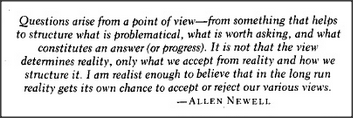



I first conceived the idea of frames in the early 1970s, while working on making a robot that could see, and I described the theory in a 1974 essay entitled A Framework for Representing Knowledge. The essay influenced the next decade of research on Artificial Intelligence, despite the fact that most readers complained that its explanations were too vague. In retrospect, it seems those explanations were at just the right level-bands of detail to meet the needs of that time, which is why the essay had the effect it did. If the theory had been any vaguer, it would have been ignored, but if it had been described in more detail, other scientists might have tested it, instead of contributing their own ideas. Then they might have found my proposals were inadequate. Instead, many versions were suggested by other people, and frame-based programming became popular.
Two students in particular, Scott Fahlman and Ira Goldstein, claimed to understand what I had meant — and then explained many details I hadn't imagined at all. Another student, Terry Winograd, worked on making a robot that understood a certain class of English-language sentences; this led to important theories about the relation between grammar and its effect upon a listener. Then, since that robot's task was building towers of children's blocks, Winograd also worked out many details of how to make a Builder. You can see how his theories affected this book. Yet another student, Eugene Charniak, worked on the problem of how young children understand the stories they read. He spent at least a solid year thinking about one such story, which had to do with bringing a kite to a birthday party. Shortly, you'll see the influence Charniak had on this book.
All along, I had felt that the frame idea itself was rather obvious and perhaps implicit in the earlier work of psychologists like Bartlett. I considered the more important concept in the 1974 essay to be the idea of a frame-system — renamed frame-array in this book. I was surprised that the frame idea became popular while the frame-array idea did not. The neme concept emerged in 1977 (under the term C-lines); the K-line idea crystallized in 1979. The concept of pronomes was in my unconscious mind for several years but did not crystallize until, while writing this book, I realized how to reformulate several of Roger Schank's early ideas into the form of Trans-frames. The scheme proposed in this book, in which the frame-terminals are controlled by bundles of nemes or isonomes, did not emerge until a full decade after the original concept of a frame-array.
Many questions remain about how frames might work. For example, it should be possible to recognize several different things at once by using different frames in parallel. But how can we see many faces in a crowd at once, or bricks in a wall, or chairs in a room? Do we make many copies of the same frame? I suspect that's impractical. Instead, perhaps we match each frame only to one example at a time — and simply assume that the same frame also applies to every other visible object that shares some characteristic features with the object under attention.